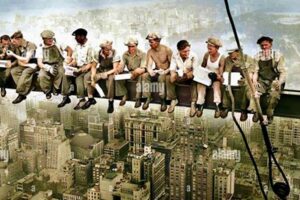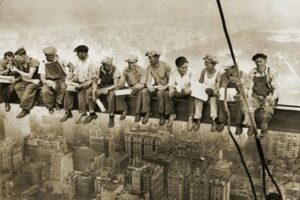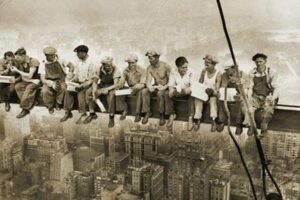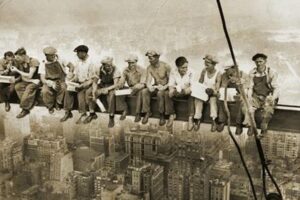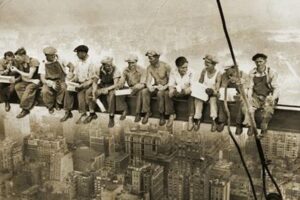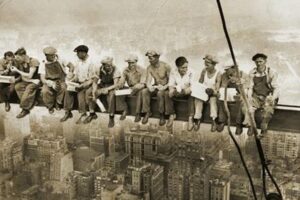The iconic photograph titled “Lunch atop a Skyscraper” depicts eleven ironworkers nonchalantly eating lunch while sitting on a steel beam, hundreds of feet above the ground, during the construction of the RCA Building in New York City in 1932. The image has become a symbol of the bravery and skill of ironworkers and the daring spirit of American construction workers during the Great Depression.
The photograph was taken by Charles C. Ebbets, a photographer for the Bethlehem Steel Corporation. Ebbets was tasked with taking promotional photos of the construction of the RCA Building, and he decided to capture the ironworkers’ lunch break as a way to show the human side of the project. The photograph was published in the New York Herald Tribune on October 2, 1932, and it quickly became a sensation.
The photograph has been used in numerous publications and exhibitions, and it has become a symbol of American ingenuity and determination. It is also a reminder of the dangers that construction workers face every day. According to the Occupational Safety and Health Administration (OSHA), falls are the leading cause of death in the construction industry. In 2021, there were 351 fatal falls in the construction industry, accounting for 39.2% of all construction worker deaths.
1. Ironworkers
Ironworkers are the men who build and repair iron and steel structures, including skyscrapers, bridges, and other large structures. They are responsible for erecting the framework of a building, as well as installing the steel beams, girders, and other components that make up the structure. Ironworkers are highly skilled and experienced workers who must be able to work at great heights and in dangerous conditions.
- Role in “Lunch atop a Skyscraper”
The ironworkers in the photograph “Lunch atop a Skyscraper” were responsible for constructing the steel framework of the RCA Building in New York City. They worked hundreds of feet above the ground, without any safety nets or other protective equipment. The photograph captures a moment of camaraderie and bravado among the ironworkers, who were proud of their work and the risks they took to complete it.
- Skills and Experience
Ironworkers must have a high level of skill and experience in order to perform their jobs safely and efficiently. They must be able to read blueprints, operate heavy machinery, and work at great heights. Ironworkers also need to be able to work in a team environment and follow instructions from their supervisors.
- Working Conditions
Ironworkers often work in dangerous conditions, including at great heights, in inclement weather, and around heavy machinery. They are also exposed to a variety of hazards, including falls, electrical shocks, and burns. Ironworkers must take precautions to protect themselves from these hazards, including wearing safety gear and following safety procedures.
- Importance of Ironworkers
Ironworkers play a vital role in the construction industry. They are responsible for building and repairing the steel structures that make up our cities and infrastructure. Ironworkers are highly skilled and experienced workers who deserve our respect and admiration.
The photograph “Lunch atop a Skyscraper” is a powerful reminder of the skill, bravery, and hard work of ironworkers. These men played a vital role in the construction of some of the world’s most iconic buildings, and they continue to play a vital role in the construction industry today.
2. Skyscraper
Skyscrapers are tall buildings that have more than 40 stories and are at least 400 feet tall. They are often built in urban areas to maximize land use and accommodate a large number of people. Skyscrapers are complex structures that require a great deal of engineering and construction expertise.
- Role in “Lunch atop a Skyscraper”
The photograph “Lunch atop a Skyscraper” was taken during the construction of the RCA Building in New York City in 1932. The RCA Building was one of the first skyscrapers to be built in the city, and it was a marvel of engineering at the time. The photograph captures the ironworkers who were responsible for constructing the building’s steel framework, sitting on a steel beam hundreds of feet above the ground. The photograph is a powerful reminder of the skill and bravery of the ironworkers who built the world’s first skyscrapers.
- Engineering and Construction
Skyscrapers are complex structures that require a great deal of engineering and construction expertise. The engineering team must design the building to withstand wind, earthquakes, and other natural disasters. The construction team must then execute the engineer’s design safely and efficiently. Skyscrapers are a testament to the skill and ingenuity of the engineers and construction workers who build them.
- Urban Planning
Skyscrapers are often built in urban areas to maximize land use and accommodate a large number of people. By building up, rather than out, cities can save valuable land space and create more livable and sustainable communities. Skyscrapers can also help to reduce traffic congestion and air pollution by concentrating people and businesses in a central location.
- Cultural Impact
Skyscrapers have a significant cultural impact. They are often seen as symbols of power, wealth, and progress. Skyscrapers can also be a source of civic pride and identity. For example, the Empire State Building is one of the most iconic buildings in the world and is a symbol of New York City.
Skyscrapers are a marvel of engineering and construction. They are a testament to the skill and ingenuity of the people who build them. Skyscrapers have a significant impact on our cities and our lives. They are a symbol of progress and prosperity, and they continue to shape the skylines of our cities.
3. Construction
Construction is the process of building or assembling something, typically a building or other structure. It involves the use of materials such as wood, concrete, and steel, as well as tools and equipment. Construction is a complex and challenging process that requires a high level of skill and expertise.
The photograph “Lunch atop a Skyscraper” is a powerful reminder of the dangers of construction work. The ironworkers in the photograph were working hundreds of feet above the ground, without any safety nets or other protective equipment. They were at risk of falling, being struck by falling objects, or being electrocuted. Despite the dangers, the ironworkers continued to work, because they knew that their work was essential to the construction of the skyscraper.
Construction is a vital industry that plays a key role in our economy and our society. Construction workers build the homes, schools, hospitals, and other buildings that we use every day. They also build the roads, bridges, and other infrastructure that we rely on to get around and to transport goods and services.
The photograph “Lunch atop a Skyscraper” is a reminder of the skill, bravery, and hard work of construction workers. These men and women play a vital role in our society, and we owe them a debt of gratitude for their work.
4. Lunch
In the photograph “Lunch atop a Skyscraper,” the ironworkers are sitting on a steel beam, hundreds of feet above the ground, eating their lunch. This image has become iconic, representing the bravery and skill of ironworkers during the construction of skyscrapers in the early 20th century. But what does the act of eating lunch have to do with the deaths of ironworkers?
- A break from the dangers of the job
Lunchtime was a time for the ironworkers to relax and take a break from the dangerous work of constructing skyscrapers. They would often sit on a steel beam, high above the ground, and eat their lunch while enjoying the view. This was a way for them to de-stress and forget about the dangers of their job, even if only for a short time.
- A chance to socialize
Lunchtime was also a chance for the ironworkers to socialize and talk to each other. They would often share stories about their families, their lives, and their work. This was a way for them to build camaraderie and support each other through the difficult and dangerous work that they did.
- A reminder of the risks
Even though lunchtime was a time for the ironworkers to relax and socialize, it was also a reminder of the risks that they faced every day. The ironworkers in the photograph “Lunch atop a Skyscraper” are sitting on a steel beam, hundreds of feet above the ground, with no safety nets or other protective equipment. This image is a reminder of the dangers that ironworkers faced every day, and the fact that they often risked their lives to build the skyscrapers that we take for granted today.
The act of eating lunch is a simple and everyday one, but in the context of “lunch atop a skyscraper deaths,” it takes on a new meaning. It becomes a symbol of the bravery, skill, and camaraderie of ironworkers, as well as a reminder of the risks that they faced every day.
5. Danger
The construction of skyscrapers is a dangerous undertaking. Workers are exposed to a variety of hazards, including falls, electrical shocks, and fires. In the early 20th century, when the photograph “Lunch atop a Skyscraper” was taken, safety regulations were not as stringent as they are today, and workers often worked without any safety equipment. As a result, many ironworkers were killed or injured during the construction of skyscrapers.
The photograph “Lunch atop a Skyscraper” is a powerful reminder of the dangers that ironworkers faced every day. The ironworkers in the photograph are sitting on a steel beam, hundreds of feet above the ground, with no safety nets or other protective equipment. They are eating their lunch, but they are also aware of the dangers that they are facing. The photograph is a reminder that the construction of skyscrapers is a dangerous undertaking, and that the workers who build these structures deserve our respect and admiration.
The danger that ironworkers faced was a major factor in the deaths of many of them. Falls were the leading cause of death, but ironworkers were also killed by electrical shocks, fires, and other accidents. The lack of safety regulations and the use of unsafe equipment contributed to the high number of deaths. Today, safety regulations are much more stringent, and ironworkers are required to wear safety equipment and follow safety procedures. As a result, the number of deaths has decreased significantly.
6. Bravery
The construction of skyscrapers is a dangerous undertaking. Workers are exposed to a variety of hazards, including falls, electrical shocks, and fires. In the early 20th century, when the photograph “Lunch atop a Skyscraper” was taken, safety regulations were not as stringent as they are today, and workers often worked without any safety equipment. As a result, many ironworkers were killed or injured during the construction of skyscrapers.
The photograph “Lunch atop a Skyscraper” is a powerful reminder of the bravery of ironworkers. The ironworkers in the photograph are sitting on a steel beam, hundreds of feet above the ground, with no safety nets or other protective equipment. They are eating their lunch, but they are also aware of the dangers that they are facing. The photograph is a reminder that the construction of skyscrapers is a dangerous undertaking, and that the workers who build these structures deserve our respect and admiration.
The bravery of ironworkers is not just about their willingness to work in dangerous conditions. It is also about their ability to face their fears and to overcome them. Ironworkers know that there is always a risk of death or injury when they are working on a skyscraper, but they are not afraid to do their job. They are brave enough to face the dangers and to build the structures that we rely on every day.
7. Skill
The construction of skyscrapers is a complex and challenging undertaking that requires a high level of skill and expertise. Ironworkers, the men who build skyscrapers, must be able to read blueprints, operate heavy machinery, and work at great heights. They must also be able to work in a team environment and follow instructions from their supervisors.
The photograph “Lunch atop a Skyscraper” is a powerful reminder of the skill and bravery of ironworkers. The ironworkers in the photograph are sitting on a steel beam, hundreds of feet above the ground, with no safety nets or other protective equipment. They are eating their lunch, but they are also aware of the dangers that they are facing. The photograph is a reminder that the construction of skyscrapers is a dangerous undertaking, and that the workers who build these structures deserve our respect and admiration.
The skill of ironworkers is not just about their ability to perform their jobs safely and efficiently. It is also about their ability to work together as a team to overcome challenges and to build structures that are both beautiful and functional. Ironworkers are an essential part of the construction industry, and their skills are essential to the construction of skyscrapers and other tall structures.
8. Great Depression
The Great Depression was the twentieth century’s longest, deepest, and most widespread decline in the global economy. The consequences of the Great Depression were felt by all, including the construction industry. Construction projects were halted, and many ironworkers were left unemployed.
- Unemployment
The Great Depression caused widespread unemployment in the United States. In 1933, the unemployment rate reached 25%, and millions of Americans were out of work. The construction industry was particularly hard hit by the Depression. Construction projects were halted, and many ironworkers were laid off.
- Loss of Income
The Great Depression caused a loss of income for many Americans. Those who were able to keep their jobs often saw their wages cut. Ironworkers who were laid off lost their entire income. This made it difficult for them to support their families and pay their bills.
- Hunger and Homelessness
The Great Depression caused widespread hunger and homelessness in the United States. Many people lost their homes and were forced to live on the streets. Ironworkers who were unemployed often had difficulty finding food and shelter.
- Psychological Distress
The Great Depression caused widespread psychological distress in the United States. Many people felt hopeless and lost. Ironworkers who were unemployed often felt worthless and ashamed.
The Great Depression had a devastating impact on the lives of ironworkers. They lost their jobs, their income, and their homes. They also suffered from hunger, homelessness, and psychological distress. The photograph “Lunch atop a Skyscraper” is a reminder of the difficult times that ironworkers faced during the Great Depression.
9. American spirit
The photograph “Lunch atop a Skyscraper” is often seen as a symbol of the American spirit. The ironworkers in the photograph are sitting on a steel beam, hundreds of feet above the ground, with no safety nets or other protective equipment. They are eating their lunch, but they are also aware of the dangers that they are facing. The photograph is a reminder that the construction of skyscrapers is a dangerous undertaking, and that the workers who build these structures deserve our respect and admiration.
- Courage
The ironworkers in the photograph “Lunch atop a Skyscraper” are demonstrating great courage. They are not afraid to work in dangerous conditions, and they are willing to take risks to get the job done. Courage is an essential part of the American spirit. It is what has allowed Americans to overcome challenges and to build a great nation.
- Determination
The ironworkers in the photograph “Lunch atop a Skyscraper” are also demonstrating great determination. They are determined to build the skyscraper, and they are not going to let anything stop them. Determination is another essential part of the American spirit. It is what has allowed Americans to achieve great things, even when faced with difficult challenges.
- Optimism
The ironworkers in the photograph “Lunch atop a Skyscraper” are also demonstrating great optimism. They are optimistic that they will be able to build the skyscraper, and they are confident that they will be able to overcome any challenges that they face. Optimism is another essential part of the American spirit. It is what has allowed Americans to stay positive even during the most difficult times.
- Resilience
The ironworkers in the photograph “Lunch atop a Skyscraper” are demonstrating great resilience. They are resilient in the face of danger, and they are resilient in the face of challenges. Resilience is another essential part of the American spirit. It is what has allowed Americans to bounce back from setbacks and to keep moving forward.
The photograph “Lunch atop a Skyscraper” is a powerful reminder of the American spirit. The ironworkers in the photograph are demonstrating courage, determination, optimism, and resilience. These are the qualities that have made America great, and they are the qualities that will continue to make America great in the future.
FAQs about “Lunch atop a Skyscraper Deaths”
What is the significance of the photograph “Lunch atop a Skyscraper”?
The photograph “Lunch atop a Skyscraper” is a iconic image that captures the bravery and skill of ironworkers during the construction of skyscrapers in the early 20th century. The photograph shows eleven ironworkers sitting on a steel beam, hundreds of feet above the ground, eating their lunch. The photograph has become a symbol of the American spirit and the can-do attitude of the American people.
Who are the ironworkers in the photograph?
The ironworkers in the photograph are members of the Mohawk Iron Workers union. They were responsible for constructing the steel framework of the RCA Building in New York City. The ironworkers in the photograph are (from left to right):
- Joe Curtis
- Frank McSorley
- Russ Gerhardt
- Allie Sloat
- Clarence Thomas
- Gus Perconte
- Walter Skinnon
- Ed Hynes
- Jimmy Thornton
- Matt O’Shaughnessy
- Bill Jones
What were the working conditions like for ironworkers in the early 20th century?
The working conditions for ironworkers in the early 20th century were extremely dangerous. Ironworkers worked at great heights, often without any safety equipment. They were exposed to the elements, as well as to the dangers of falling objects and electrical shocks. Many ironworkers were killed or injured during the construction of skyscrapers.
What is the legacy of the ironworkers who built the skyscrapers of the early 20th century?
The ironworkers who built the skyscrapers of the early 20th century left a lasting legacy of skill and bravery. Their work helped to build some of the world’s most iconic buildings, and their spirit of determination and can-do attitude is an inspiration to us all.
What can we learn from the photograph “Lunch atop a Skyscraper”?
The photograph “Lunch atop a Skyscraper” teaches us about the bravery, skill, and determination of the ironworkers who built the skyscrapers of the early 20th century. It also reminds us of the importance of safety in the workplace and the need to recognize and appreciate the work of construction workers.
The photograph “Lunch atop a Skyscraper” is a powerful reminder of the American spirit and the can-do attitude of the American people. It is a reminder that anything is possible if we set our minds to it.
Tips to Prevent Construction Accidents
The photograph “Lunch atop a Skyscraper” is a reminder of the dangerous working conditions that ironworkers faced in the early 20th century. Today, thanks to advances in safety regulations and equipment, construction work is much safer. However, construction accidents still happen. Here are five tips to help prevent construction accidents:
Tip 1: Wear proper safety gear.
This includes a hard hat, safety glasses, gloves, and steel-toed boots.
Tip 2: Be aware of your surroundings.
Pay attention to where you are walking and working. Be aware of potential hazards, such as trip hazards, falling objects, and electrical wires.
Tip 3: Follow safety procedures.
These procedures are in place for a reason. Always follow them, even if it seems like a hassle.
Tip 4: Report unsafe conditions.
If you see something unsafe, report it to your supervisor immediately. Don’t wait until it’s too late.
Tip 5: Take breaks.
It’s important to take breaks throughout the day to rest and hydrate. This will help you stay alert and focused, which can help prevent accidents.
By following these tips, you can help prevent construction accidents and keep yourself and your coworkers safe.
The photograph “Lunch atop a Skyscraper” is a reminder of the importance of safety in the workplace. By taking the necessary precautions, we can help prevent construction accidents and ensure that everyone goes home safe at the end of the day.
Conclusion
The photograph “Lunch atop a Skyscraper” is a powerful reminder of the bravery, skill, and determination of the ironworkers who built the skyscrapers of the early 20th century. It is also a reminder of the dangers that construction workers face every day. Today, thanks to advances in safety regulations and equipment, construction work is much safer. However, construction accidents still happen. By following the tips outlined in this article, we can help prevent construction accidents and keep ourselves and our coworkers safe.
The photograph “Lunch atop a Skyscraper” is a reminder that anything is possible if we set our minds to it. It is a reminder that we can overcome any challenge, no matter how difficult it may seem. Let us all be inspired by the example of the ironworkers who built the skyscrapers of the early 20th century. Let us all work together to build a better future for ourselves and for our children.


